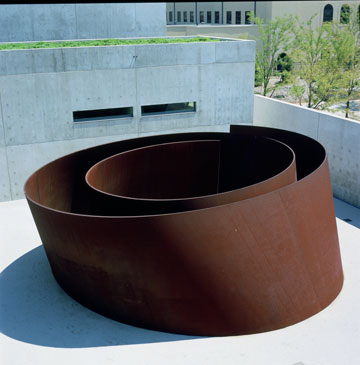Art installation = my favorite time to blog. In fact, while writing this, I found an embarrassing number of posts about installation in our archives. I think it plays into why I like blogging in the first place – they are the ultimate behind-the-scenes stories of how exhibitions come to life. I like hearing how they figure out how to handle an installation, I like harassing our registrars about their jobs (which they love too ….*cough cough*) and what I really like are installations of works that are extra challenging (and usually very heavy). Two of my favorite examples also happen to be from an Art:21 artist: Richard Serra.
Richard Serra’s works present a range of installation challenges. Our facilities manager Steve Morby calls his works an “instable stability…when they’re assembled they are relatively stable, the problem comes when you start to disassemble or put them together.” Before we opened our exhibition Dan Flavin: Constructed Light, we de-installed two works from the galleries. Standpoint and Joplin were highly complex (i.e. HEAVY) works to move. Here’s Steve explaining how they handled this:
Aside from the building itself, I think our most dramatic undertaking has to be Serra’s work Joe. One of my first installation posts, I think it’s still my favorite and worth re-visiting. The story is complete with ocean steamers from Germany, Mississippi River barges, and the biggest crane in St. Louis…..want more?
Commissioned for the courtyard, it’s Serra’s first torqued spiral and consists of five cor-ten steel plates weighing 25 tons each. Manufactured in Germany, they traveled via ocean steamer across the Atlantic, and up the Mississippi River via barge.
After reaching the Pulitzer, the plates traveled on a flatbed truck through the streets of St. Louis.
A mat of concrete provides the foundation to support the weight of the plates in courtyard. Little “feet” on the concrete mat hold the plates in position above the concrete. They had to order the biggest crane they could find in St. Louis to lift these five plates into the courtyard.
It was important to make sure that everything was positioned perfectly, before the plates could be welded into the feet. The plates are not welded to each other. A small, dog bone-sized piece of metal is inserted where the plates meet, at the top and bottom of that seam. Serra didn’t like the fact that you can see through the seam between the plates, so black foam was inserted to make the gaps less evident.
The walking surface of the courtyard consists of compacted limestone gravel. Before this could be put into place, a draining system had to go underneath Joe, otherwise the center would turn into a huge puddle when it rained. Perforated drain pipes were installed, so water could run into the pipes from the ground, and then run out. After this, they compacted the gravel tightly on all the walking areas. However, they left the gravel loose around the base of the sculpture. That way, when it rains, the water can run down the sides of the plates, through the looser gravel, and into the pipes. Also, Joe still sits on those feet, which are now hidden by the gravel.
Cor-ten steel is designed to rust, and Joe has built up an impressive coating over seven years. The work has developed from a bright orange into a deep chocolately maroon color.
The building manager told me that when Joe was installed, it had to be watered twice a day to encourage this rusting. One of the workers asked him, “Why water it? Hoping it will grow bigger or something?”
